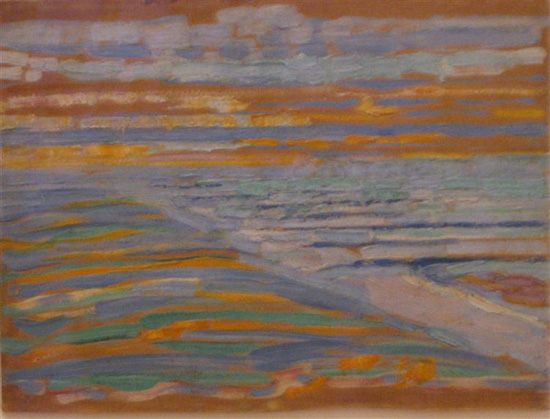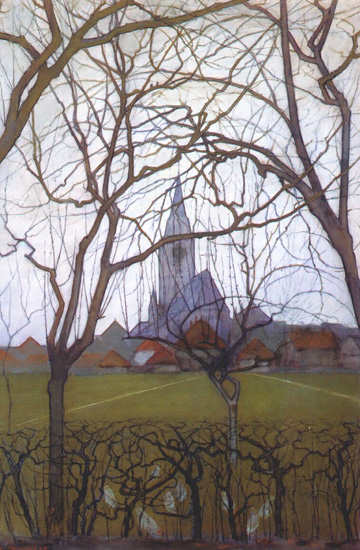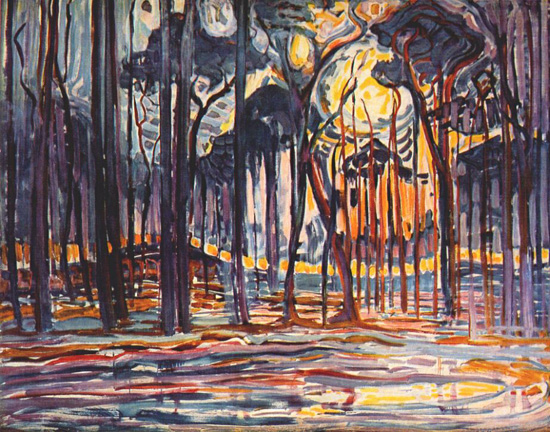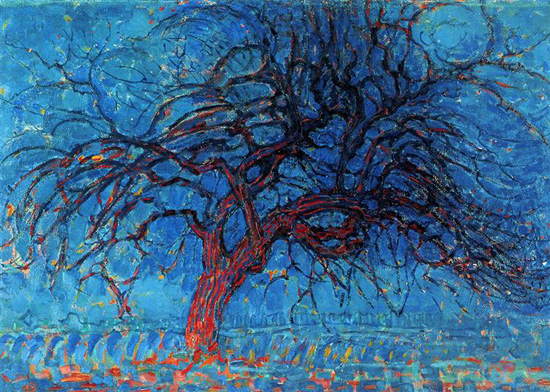Perpetual Ripplets: Mondrian 1872-1944
Yuko Otomo
June 2017
 View from the Dunes with Beach and Piers, 1909, Wikiart
View from the Dunes with Beach and Piers, 1909, Wikiart
Piet Mondrian: 1872-1944
Part One: Room #1, 2, 3
I headed to the retrospective with an unusual tension as well as the determination of a mountain climber about to challenge the hardest, towering, impossible summit. The exhibition had the subtitle: Rhythm in Abstraction, as if to call for the attention of the general mass by suggesting his love for Jazz, maybe not so much by way of the abstract context of the word “Abstraction,” but that it was directed toward people’s affinity for the word “Rhythm” is certain. As I tried to calm the unstable floating sensation inside myself caused by this extreme tension, I let myself go along with the flow of the show.
As I got ready a few days later to write my reactions to the exhibition, I decided to re-read The New Art – The New Life: The Collected writing of Piet Mondrian (edited & translated by Harry Holtzman & Martin S. James, published by G. K. Hall & Co.), and pulled it out from the bookshelf. Staying home without going out at all for 2 days, I read some segments & took notes. I wondered awkwardly why I tried to do such a thing, a kind of an intellectual re-enforcement, in preparation for the writing. But then I realized that it was extremely natural that I did that. It was to re-examine my own personal reactions to the MoMA retrospective that I had just gone through. I thought it was important to not be fixed on wrong ideas because of half-fledged mistakes or misunderstandings of the subject on my part.
Eventually, I decided to give a simple shape to what I was thinking & feeling as I looked at each room of the retrospective, following the notes I took without getting too involved in the book itself.
 Village Church, 1898, Wikiart
Village Church, 1898, Wikiart
Room 1
Early works (1898-1908). Early works of great artists always clearly & decisively show the who & what of their beings, & where their spiritual qualities lay, without fail. Mondrian’s serene melancholy, devoid of the usual senses of anxiety & agitated anticipation, overlaps itself on some sort of sensuality to deliver his basic personality to us. He could be mistaken for a Romantic because of the melancholic subjects & the dark tonality of his works. But these early works tell us of the reality of his unique sensitivity, one that does not fall into being romantic because of the extremely serene & calm inborn passion he carried inside him.
Village Church (1898 watercolor & gauche on paper) evokes an empathy in conveying the coldness of air & wet earth through the piercingly sharp silence. The landscape of the Gein River outside of Amsterdam repeats its image one after another throughout his characteristically serial studies. This habitual method of searching the mystery of art by using the same motif again & again stayed with him all through his life. Evening on the Gein with Isolated Tree (1907-1908 watercolor & gauche on paper), similar to Munch & other Nordic artists’ works, makes me feel like as if I were looking into a mass of heavy emotions, dark & abstract, something that cannot be shaped into any particular form in the eternal void. There, the color pink leaves a sensual impression. Riverscape with Pink, Yellow & Green Sky (1907-1908 oil on canvas) also shows abstract emotions, & it makes me think of Degas’ landscapes. Beech Forest (1898-1899 watercolor, gauche on paper) somehow reminded me of Klimt because of the tree motif. What a surprise to see the presence of Vertical-Horizontal already clearly in Geinrust Farm(1900-1902 oil on canvas)! Although I am not sure if Mondrian was conscious of the meaning of their existence, it is quite fascinating to see the passionate curiosity toward Vertical-Horizontal already budding there. Out of this series of landscape works, Geinrust Farm in Watery Landscape (1906) is my favorite. This work gives me the feeling of the artist seeing nature spreading in front of him with his “skin” rather than with his “eyes.” Here, too, the presence of Vertical-Horizontal is evident, showing typical abstract emotions. Geinrust Farm in the Mist (1906-1907 oil on canvas) looks as if the abstract emotions have wiped the void out. This work is another favorite of mine. A small work titled Self-Portrait: Eyes (1908-1909 charcoal on paper) is an important work that shows Mondrian’s determined will as an artist.
Sound & Silence.
 Woods near Oele, 1908, Wikiart
Woods near Oele, 1908, Wikiart
Room 2
It is clear that he’s going through Fauve influences. Having been baptized by Modernism, Mondrian tries to get out of traditionalism. Going beyond his own serene personality, it is as if the new consciousness is doing a face to face encounter with his own deeply hidden passion inside him. Lighthouse at West Kapelle (1908-09 oil on canvas) has a strong Matisse influence. He moves on, surpassing his sensitivity. The new method is taken to achieve new creative motives. In his world, the cliché expression: “going beyond tradition” to reach the new breathes its own certainty further. Here, again, the unusual awareness of Vertical/Horizontal gains intensity. Woods near Oele (1908 oil on canvas) evokes something similar to Munch’s work again. Yet, strangely, it is clearly free of the “sickly-ness” that Munch’s work carries. It looks as if he is looking for “something” beyond silence. Dune I (1909 oil on cardboard), suggesting brightness beyond graveness, creates a tranquil balance of some sort. A study: Sea toward Sunset (1909 oil on cardboard), showing Seurat’s pointillism influences, displays some elements that predict his future characteristics with the appearance of flat strokes. Dune II (1909) again shows Fauve influences. Despite the fact that Modernism influenced him toward a vital shift in the direction of technical & conceptual aspects, his peculiar manner of truth searching for his own existence teaches him how not to be overshadowed by it. His sense, always clear, cool & awakened, does not allow him to be the victim of influences. Unmistakably, Seascape (1908) must have been created under a strong influence by Van Gogh, but strangely, there are no personal nuances of Van Gogh, such as an anxiety or a compressed passion. Reversely, this à la Van Gogh work shows a confidence & a certainty, something oppositional to anxiety. This irony is fascinating.
 Lily, Wikiart
Lily, Wikiart
Room 3
My knowledge of Theosophy is limited. Having been called “Occult” or “Mysticism,” this spiritual-quest movement, according to the panel at the exhibition space, is “a blend of Eastern & Western religion affirming humanity’s evolution toward a universal brotherhood.” I don’t know what kind of philosophical discourses it involved in depth; I only know its basics. It’s nothing surprising, but natural for Mondrian, with his earnest personality, to have an ardent interest in this spiritual movement. “To see God”; “To approach God”; “To know God”… Instead of being inspired by involving himself in Theosophy, it is more accurate to say that a passion for a spiritual evolution & a spiritual unity had already been in him as part of his personality & sensitivity from the beginning. It is more as if the direction he was aiming at got clearer & intensified by his involvement in it. Just like the time he was under the intense influences of Fauvism & Pointillism, influences never swallowed him up. Mondrian always knew how to utilize them to his advantage in expanding his search for truth. A spiritual unity & a spiritual evolution had clearly been his life long subjects from the beginning.
Red Tree (1908 oil on canvas) & Blue Tree (1908 tempera on cardboard) invite my personal curiosity since I had once created a similar motif in one of my early works, blindly, without knowing anything about art history. Tiger Lily (1909 chalk & charcoal on paper) now carries the new style of signature: one symbol created by combining two initials of his name: P & M. Amaryllis (1910 watercolor on paper) is so beautiful that it hurts my heart. Even when he paints flowers, they never end up as mere sketches of “nature”. It is as if to induce us to depart to “the world behind” it. He is clearly aware of the abstract power of painting itself. Summer Dunes in Zeeland (Dune VI) (1910 oil on canvas) is a big work, size-wise. It shows us that he is working on the method of “abstracting” by the simplification of matters. Red Mill at Domburg (1911 oil on canvas) for some reasons keeps me think of a work by Robert Moskowitz.
Mysterious & existential power of Color & Form… An autonomous self-existing power of Color & an autonomous power of Form are demonstrated here to prove the truth.

 Avond (Evening): The Red Tree, 1908-1910, Wikiart
Avond (Evening): The Red Tree, 1908-1910, Wikiart